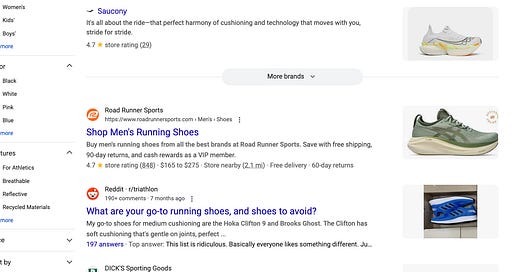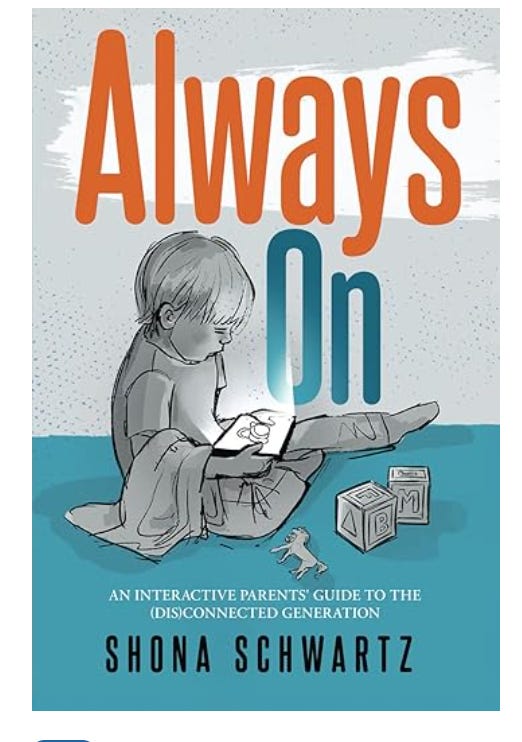Your users are people too
Most SEO has a fundamental flaw: it begins with the wrong starting point.
This week’s newsletter is sponsored by North Star Inbound and my wife’s new book, Always On: An Interactive Parents' Guide to the (Dis)Connected Generation. Please buy, read, and share!
Most SEO has a fundamental flaw: it begins with the wrong starting point.
There is a myopic marketing fixation on what we broadly term “users.” This term, ubiquitous across all marketing and metrics (DAU, MAU…., etc.), reduces individuals to data points: clicks, session durations, conversion rates, and cohorts. This mythical user is brought to life with keyword research, behavioral tracking systems, and performance metrics designed to dissect and interpret the actions of these users with granular detail.
[Sponsored]
The average 5-year-old spends 3 hours per day in front of a screen.
That's 1000 hours, which is the equivalent of 41 days per year!
Most parents know this isn't ideal but don't know good alternatives. Most books and research focus on how bad screens are for kids and teens but not what to do instead.
Screen abstinence isn't an option. Ask any parent who yanked a phone/tablet/game console/TV away from their kids without presenting alternatives.
Here's a different take. Read Always On: An Interactive Parents’ Guide for the (Dis)connected Generation and proactively make the choices that allow kids to free their minds from screens.
These tools provide valuable insights into engagement patterns and, used effectively, would inform tactical adjustments. However, for all its technical sophistication, this approach overlooks the essential inquiry with which I begin every consulting engagement I take on:
Who is your customer?
Beyond the keywords they enter, what compels them to seek answers from a search engine? Why are they opening up a search engine or app? Does this fictionalized user even need a search engine, or are they likely to seek a friend for help with their issue? Who do you think they genuinely are?
This question bizarrely is outside the operational scope of SEO today. SEO efforts often presume the customer is already poised and ready to act, whether that action be a purchase, a subscription, or some other predefined goal on the website that “ranks” highly on Google because they searched a query.
To that end, most SEO efforts devote considerable energy to decoding search intent, extrapolating meaning from that query. For instance, a search for “running shoes” is interpreted as a signal of imminent buying intent, prompting marketers to optimize landing pages with product comparisons or promotional offers. This assumption, however, may be premature.
Queries aren’t people
Attempting to view this person as an individual with only the query as a clue would show that we don’t have a lot of clarity on who the person is. An individual typing that query could be male or female, younger or older, shopping or researching, buying for themselves or for another. Each of these specific people, NOT intents, would require a different landing experience. A woman shopping for running shoes would more likely want to land on a page with women’s running shoes … or she could be shopping for someone else and wants to see the product that matches that person.
This simple search phrase might match the intent of shoe buying, but it tells us nothing else about what this user seeks. With this in mind, it’s clear that optimizing for a broad search term isn’t enough if you want to drive a conversion and not just a click (or, worse, a ranking).
Understanding the why to learn the who
The tools and techniques we rely upon excel at capturing what people search for and how they navigate the results, but they fall short of illuminating the “why” meaning, the underlying motivations or emotions that drive someone to turn to Google (or another engine) in the first place.
To me, this isn’t just a philosophical approach. It carries profound implications for the nature of an SEO effort. Without identifying the user, SEO will take a completely different direction and will likely fail to achieve the potential this channel should bring.
In my opinion, things go even further off the rails when technical SEO is introduced, and engineers are shoehorned into updating internal links, site structure, page speed (!), and layouts, which are designed to satisfy SEO best practices but might not be applicable for the actual person. The strategy might be sound, but the target is wrong.
Don’t optimize for the algo
With a query focus, the SEO teams have become architects of a digital experience optimized for algorithms rather than human beings. In the typical SEO playbook, the customer is reduced to a means to an end, a variable to be manipulated rather than a person to be understood. Transitioning to a genuinely user-centric SEO approach is not as complex as it may seem. It really does begin with asking that one essential question: Who is this individual, and what is motivating them to search?
To pursue this line of thought requires most people to step beyond the comfort of data dashboards and into the less specific terrain of empathy and imagination. Fortunately for anyone concerned about their jobs being usurped by AI, emotion and creativity are skills that today require humans, not just analytical reasoning pretending to be human.
Motivations are deeper than intent
To illustrate this with an example, Parents searching for “educational toys for toddlers” may not simply be shopping; they might be wrestling with guilt over limited playtime with their child or seeking reassurance that they are fostering development amid a busy schedule. They may be looking for alternatives to screen time on a device or video games on a TV. Neither of these use cases would be captured by traditional query research.
From a business standpoint, someone querying “CRM software” might not be ready to buy but rather explore options to alleviate the stress of a chaotic workflow they can no longer manage alone. These are not mere hypotheticals; they are the kinds of human realities that lurk beneath the surface of every search, realities that a query + intent driven SEO frameworks are ill-equipped to address.
Viewing these use cases from a human perspective will give you many more ideas on how to win market share and create blue ocean SEO.
SEO begins after this
None of this negates the importance of technical optimization; rather, these improvements underpin the overarching goal of addressing human needs. The words used, the architecture, and even the technology choices should match the precise human experience called for by starting with that essential question. SEO should be the tool that enables a larger purpose, not the purpose itself.
This approach is undoubtedly more labor-intensive, requiring a blend of research, intuition, and patience that most leaders will resist because it doesn’t easily fit in a neat box of delivery-based OKRs and agency contracts. Still, to restate this point again, this effort of identifying the customer is required and will guarantee long-term job security in an AI world.
Undoubtedly, AI will become even more prevalent in our daily lives, but the one constant will be human needs, and if you can identify those raw desires, your marketing skillset will always be in demand. If you align your SEO with humans by beginning every strategy with identifying those individuals as people, not just users, you will be off to a great start.
User-centricity is just a buzzword unless you know your customer. Know them as people, not just as users.
Brought to you by North Star Inbound—the sales enablement SEO agency.
Drive High Intent Leads with SEO.
What happens when you combine best-in-class SEO with conversion optimization?
BigRentz's traffic increased by 186% (85k), added 1950 conversions in 12 months.
Self Financial's traffic increased by 50k/month, and added 685 new customers.
Lastly, Secure Data added 1968 phone calls.
North Star Inbound’s SEO strategies earn leads, conversions, and revenue..
Book a call for a free content audit and 10% off any engagement.






Love, love, love. Magic happens when content is actually created for the customer. I worked with a brand last year that sold tickets for events and the content strategy I created was so strong, I sill see their posts shared on social media platforms as trusted guides for information on the event.